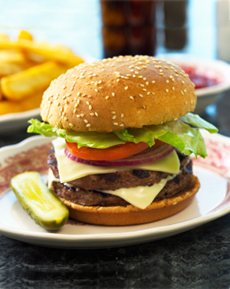TIP OF THE DAY: Find The Best Melting Cheese
|
|
If you like melted cheese on your burger, veggies, casseroles and other foods—and appreciate the flavor of good cheese—go ditch the bland American cheese slices. Take a look at the options below: Somewhere on the list is the melting cheese you’ll prefer. Why do so many people use American cheese slices? It’s what they grew up with. Due to its superior melting factor and unctuousness, caused by the emulsifying agents in the cheese, American cheese is the most popular cheese chosen for burgers and grilled cheese sandwiches. These days, Velveeta is up there too, thanks to their use on nachos in ball stadiums. It’s not even real cheese! American cheese is a “processed cheese product,” called “cold packed cheese food” (as one of our colleagues jokes, “It’s what you use to feed your cheese”). So is Velveeta. Here’s the U.S. Code of Federal Regulations that describes them. There are far better melting cheeses to be had; we’ve compiled this list for you. |
|
|
THE BEST MELTING CHEESES The more moisture in a cheese, the more easily it melts. Not surprisingly, these cheeses are also the best for fondue. Fresh cheeses: These cheeses are made for cooking: mozzarella, queso blanco, queso oaxaca, paneer, panela. Soft-Ripened Cheeses: Cheese board favorites like Brie and Camembert have naturally runny centers. They also have subtle mushroomy notes, so are delicious topped with sautéed mushrooms on that burger. Soft-ripened cheeses are uncooked, unpressed cheese, which, as a result, are creamy or even runny when fully ripe. They melt very easily. Don’t trim off the rind—it’s considered a choice part by cheese connoisseurs. Semisoft Cheeses: These cheeses, springy to the touch, melt easily. Brick, Fontina and Port Salut are popular examples, as are blue cheeses, Butter Käse, Edam, young Gouda, Havarti, Limburger, some Monterey Jacks, Muenster, young Provolone, Teleme and some Tilsits. Semihard Cheeses: This group, which includes Cheddar, Manchego and Swiss cheeses, is most popular on burgers (after the tonnage winner, American cheese). Although they don’t melt much, they maintain their shape. The difference between semi-hard and semi-soft cheeses is one of moisture: Semi-soft cheeses contain more than 45% water, while semi-hard cheeses contain 30% to 45%. A cheese can start as semi-soft, then move to semi-hard via aging, which evaporates the moisture. Hard Cheeses: Want Asiago, Parmesan or Romano on your burger or potato? This group has the lowest moisture content, so it will melt only in small shavings. We use a Microplane ribbon grater to get it to melt.
|
||



